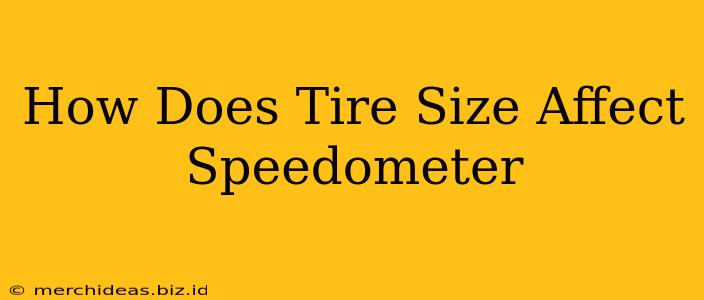Changing your tire size can significantly impact your speedometer's accuracy. Understanding this relationship is crucial for safe driving and avoiding potential legal issues. This guide explains how tire size affects your speedometer and what you need to know.
Understanding the Speedometer's Calculation
Your speedometer doesn't directly measure your speed. Instead, it relies on the rotational speed of your vehicle's transmission or driveshaft. This rotational speed is then translated into a speed reading based on the factory-installed tire size. The speedometer's calibration assumes a specific tire diameter.
When you change to a tire with a different diameter (taller or shorter), the rotational speed of your transmission/driveshaft will no longer accurately reflect your actual speed.
Larger Tires: Speedometer Reads Low
Installing larger diameter tires means your wheels rotate fewer times to cover the same distance. Consequently, your speedometer will underestimate your actual speed. You might be traveling faster than the speedometer indicates.
Example: If your speedometer shows 60 mph, you might actually be traveling closer to 65 mph with larger tires.
Smaller Tires: Speedometer Reads High
Conversely, smaller tires result in more wheel rotations to cover the same distance. Your speedometer will overestimate your speed. You might be traveling slower than the speedometer shows.
Example: If your speedometer shows 60 mph, you might actually be traveling closer to 55 mph with smaller tires.
The Impact of Incorrect Speed Readings
Inaccurate speedometer readings have several implications:
- Safety Concerns: Misjudging your speed can lead to dangerous situations, especially when braking or navigating curves.
- Fuel Efficiency: Inaccurate speed readings can affect your perception of fuel consumption.
- Legal Issues: Driving significantly faster than indicated by your speedometer could result in speeding tickets, even if you believe you're adhering to the speed limit.
Calculating the Difference
While precise calculation requires specialized tools, you can get a reasonable estimate using online tire size calculators. These calculators consider the original and new tire sizes to determine the percentage difference in speedometer readings. Many are freely available online. Simply input your original and new tire dimensions (diameter or circumference).
Important Note: These calculators provide estimates. The actual difference might vary slightly depending on several factors, including the vehicle's transmission and the accuracy of the tire measurements.
Recalibrating Your Speedometer
Some vehicles allow for speedometer recalibration via specialized tools, often requiring professional assistance. This recalibration adjusts the speedometer's calculations to match the new tire size. However, this isn't always an option for all vehicles.
Best Practices for Tire Size Changes
- Consult your vehicle's owner's manual: Check for recommendations on acceptable tire sizes.
- Consider the impact on speedometer accuracy: Before changing tire sizes, understand the potential discrepancies.
- Drive cautiously: If you've changed your tire size without recalibration, exercise extra caution and be mindful that your speedometer might not be completely accurate.
- Use a GPS device: A GPS device provides a more accurate indication of your speed, which can serve as a cross-reference.
By understanding how tire size affects your speedometer, you can drive more safely and confidently. Remember to always prioritize safe driving practices and be aware of potential inaccuracies in your speedometer reading.
